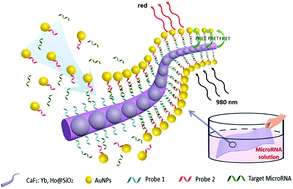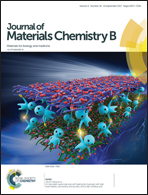Production of a fluorescence resonance energy transfer (FRET) biosensor membrane for microRNA detection†
Abstract
MicroRNAs (miRNAs) play a key role in regulating gene expression but can be associated with abnormalities linked to carcinogenesis and tumor progression. Hence there is increasing interest in developing methods to detect these non-coding RNA molecules in the human circulation system. Here, a novel FRET miRNA-195 targeting biosensor, based on silica nanofibers incorporated with rare earth-doped calcium fluoride particles (CaF2:Yb,Ho@SiO2) and gold nanoparticles (AuNPs), is reported. The formation of a sandwich structure, as a result of co-hybridization of the target miRNA which is captured by oligonucleotides conjugated at the surface of CaF2:Yb,Ho@SiO2 fibers and AuNPs, brings the nanofibers and AuNPs in close proximity and triggers the FRET effect. The intensity ratio of green to red emission, I541/I650, was found to decrease linearly upon increasing the concentration of the target miRNA and this can be utilized as a standard curve for quantitative determination of miRNA concentration. This assay offers a simple and convenient method for miRNA quantification, with the potential for rapid and early clinical diagnosis of diseases such as breast cancer.



 Please wait while we load your content...
Please wait while we load your content...